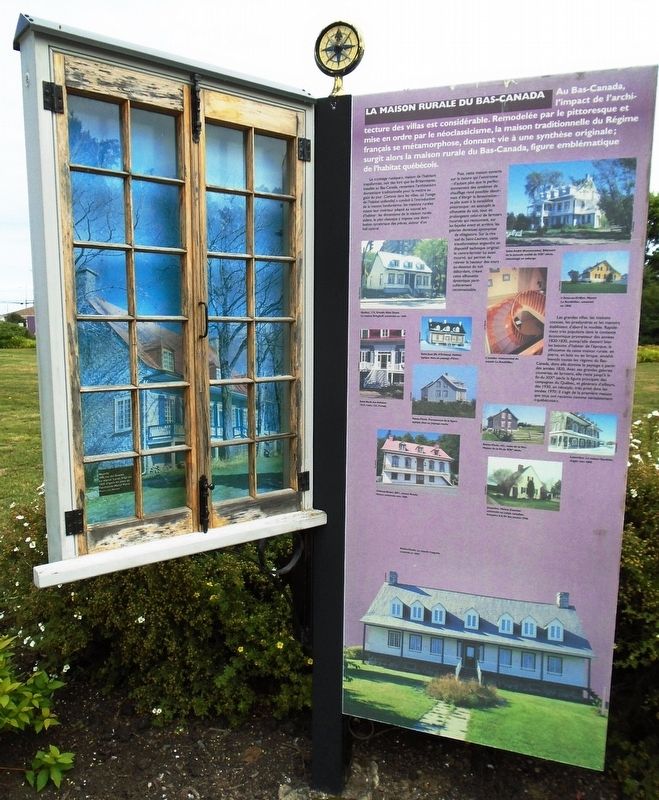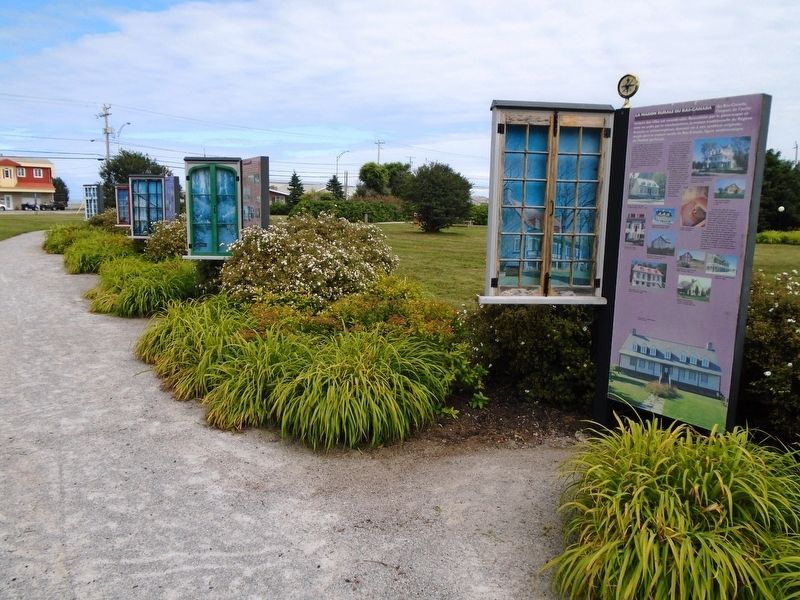La maison rurale du Bas-Canada / The Rural House of Lower Canada
Au Bas-Canada, l'impact de l'architecture des villas est considérable. Remodelée par le pittoresque et mise en ordre par le néoclassicisme, la maison traditionnelle du Régime français se métamorphose, donnant vie à une synthèse originale; surgit alors la maison rurale du Bas-Canada, figure emblématique de l'habitat québécois.
Le « cottage rustique », maison de l'habitant transformée, naît dès lors que les Britanniques, installés au Bas-Canada, remanient l'architecture domestique traditionnelle pour la mettre au goût du jour. Comme dans les villes, où l'usage de l'habitat unifamilial a conduit à l'introduction de la maison londonienne, les maisons rurales voient leur intérieur adapté au nouvel art d'habiter: les dimensions de la maison rurale aidant, le plan classique y impose une distribution symétrique des pièces, autour d'un hall central.
Puis, cette maison ouverte sur la nature qui l'environne—d'autant plus que le perfectionnement des systèmes de chauffage rend possible désormais d'élargir la fenstration—se plie aussi à la sensibilité pittoresque: on assouplit la silhouette du toit, tout en prolongeant celui-ci
de larmiers incurvés qui recouvrent, sur les façades avant et arrière, les galeries devenues synonymes de villégiature. Sur la rive sud du Saint-Laurent, cette transformation engendre un dispositif technique original: le contre-larmier lui aussi incurvé, qui permet de relever la hauteur des murs au-dessous du toit débordant, créant cette silhouette dynamique particulièrement reconnaissable.Les grandes villas, les maisons cossues, les presbytères et les manoirs établissent d'abord le modèle. Rapidement très populaire dans le contexte économique prometteur des années 1820-1830, puisqu'elle dessert bien les besoins d'habiter de l'époque, la silhouette de cette maison rurale, en pierre, en bois ou en brique, envahit bientôt toutes les régions du Bas-Canada, dont elle domine le paysage à partir des années 1820. Avec ses grandes galeries couvertes de larmiers, elle reste jusqu'à la fin de XIXe siècle la figure principale des campagnes du Québec, et générera d'ailleurs, dès 1930, un néostyle, très prisé dans les années 1970: il s'agit de la première maison que tous ont reconnu comme véritablement « québécoise ».
[Légendes photo, en haut à droite, dans le sens des aiguilles d'une montre, lisez]
• Saint-André (Kamouraska). Bâtiment de la seconde moitié du XIXe siècle, réaménagé en auberge.
• L'Anse-au-Griffon. Manoir Le Bouthillier, construit
• L'escalier monumental du manoir Le Bouthillier.
• Sainte-Flavie. 621, route de la Mer. Maison de la fin du XIXe siècle.
• Laterrière. La maison Gauthier, érigée vers 1860.
• Jonquière. Maison d'ouvrier construite en « style canadien-français » à la fin des années 1930.
• Château-Richer. 8851, avenue Royale. Maison construite vers 1860.
• Sainte-Flavie. Permanence de la figure typique dans un paysage marin.
• Saint-Roch-des-Aulnaies. 1015, route 132. Portail.
• Saint-Jean (île d'Orléans). Habitat typique dans un paysage d'hiver.
• Québec. 115, Grande Allée Ouest. La maison Krieghoff, construite en 1849.
[Grande légende inférieure de la photo se lit]
Rivière-Ouelle. Le manoir Casgrain, construit en 1834.
[La légende de la photo d'arrière-plan de la fenêtre se lit]
Neuville, 500, rue des Érables
Le manoir Larue, érigé en 1835 d'après les plans de. l'architecte Michel Patry
In Lower Canada, the impact of villa architecture is considerable. Remodeled from the picturesque and put in order by neoclassicism, the traditional house of the French Regime has metamorphosed, giving life to an original synthesis; thus emerged the rural house of Lower Canada, the emblematic figure of Quebec habitation.
The "rustic cottage," the settler's
Then this house opened on to the environment which surrounded it, all the more with heating system improvements which made it possible to expand the windows. It also lent picturesque sensibility with a relaxed roof silhouette with extended curved eaves that covered the front and rear facades. Verandas became synonymous with vacation. On the south shore of the St. Lawrence, this transformation created an original technical advance: the curved counter-arcade, which allowed the height of the walls to be raised below the overhanging roof, creating this particularly recognizable dynamic house silhouette.
Large villas, opulent houses, rectories and mansions first set the domestic pattern. Soon very popular in the promising economic context of the 1820s-1830s, since it served the needs of those living at the time, the silhouette of this rural house, whether stone, wood, or brick, soon spread from Lower Canada through all regions of Quebec, whose
[Photo captions, clockwise from the top right, read]
• Anse-au-Griffon. Le Bouthillier Manor, built in 1860.
• The monumental staircase of Le Bouthillier Manor.
• Sainte-Flavie. 621, route de la Mer. Late 19th century house.
• Laterrière. The Gauthier House, erected around 1860.
• Jonquière. Worker's house built in "French-Canadian" style at the end of the 1930s.
• Château-Richer. 8851 avenue Royale. House built around 1860.
• Sainte-Flavie. Enduring rural house style in a seascape.
• Saint-Roch-des-Aulnaies. 1015, route 132. Entry.
• Saint John (Orleans Island). Typical rural house in a winter landscape.
• Quebec. 115 Grande Allée Ouest. The Krieghoff House, built in 1849.
[Large bottom photo caption reads]
[Window background photo caption reads]
Click for more information.
• Saint-André (Kamouraska). Building from the second half of the 19th century, refitted as an inn.
Riviere Ouelle. The Casgrain mansion, built in 1834.
Neuville, 500, rue des Érables
The Larue Mansion, erected in 1835 according to the plans of architect Michel Patry
Topics. This historical marker is listed in these topic lists: Architecture • Settlements & Settlers. A significant historical year for this entry is 1820.
Location. 48° 29.059′ N, 68° 29.75′ W. Marker is in Rimouski, Québec, in Rimouski-Neigette. Marker is on boulevard du Rivage (Québec Route 132), on the right when traveling north. Marker is on the grounds of Maison Lamontagne House Historic Site. Touch for map. Marker is at or near this postal address: 707 boulevard du Rivage, Rimouski QC G5L 7L3, Canada. Touch for directions.
Other nearby markers. At least 8 other markers are within walking distance of this marker. Villas et villégiature / Villas and Resorts (here, next to this marker); Maisons des faubourgs / Suburban Houses (here, next to this marker); L'habitat ouvrier urbain / Urban Worker Housing (here, next to this marker); La maison Londonienne / The London house (a few steps from this marker); Les maisons de notables / Noteworthy Houses (a few steps from this marker); La maison urbaine en Nouvelle-France / The Urban House in New France (a few steps from this marker); Les maisons de colonisation / Settlement Houses (a few steps from this marker); La maison rurale en Nouvelle-France / The Rural House in New France (a few steps from this marker). Touch for a list and map of all markers in Rimouski.
Also see . . .
1. Traditional French-Canadian (Quebec) Architecture. Quebec History website entry (Submitted on February 20, 2019, by William Fischer, Jr. of Scranton, Pennsylvania.)
2. Canadian Architecture: 1867-1914, with further readings. The Canadian Encyclopedia website entry (Submitted on February 20, 2019, by William Fischer, Jr. of Scranton, Pennsylvania.)
3. Maison Lamontagne House Historic Site. Historic Site website homepage (Submitted on February 20, 2019, by William Fischer, Jr. of Scranton, Pennsylvania.)
Credits. This page was last revised on June 25, 2021. It was originally submitted on February 19, 2019, by William Fischer, Jr. of Scranton, Pennsylvania. This page has been viewed 219 times since then and 18 times this year. Photos: 1, 2. submitted on February 20, 2019, by William Fischer, Jr. of Scranton, Pennsylvania. 3. submitted on June 25, 2021, by Larry Gertner of New York, New York.

